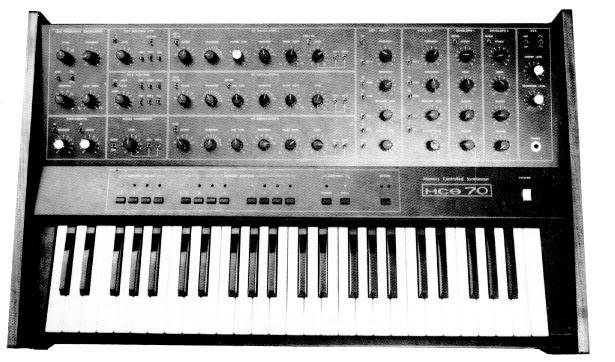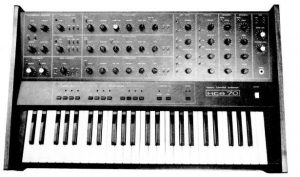Filter on ALL, SYNTH, DRUM, SAMPLER or MISC |
Total list currently 2405 items in 330 Brands |
Audio Systems Electronics | MCS 70 |
Description | The MCS70 monophonic analog synthesizer designed, built and programmed by the Italian engineer Mario Maggi. Was a kind of one hit wonder, making its one and only debut on the self titled album "Automat". The album featured the synthesizer exclusively, programmed by Maggi. The condition imposed by Mario Maggi to participate on the project was that the MCS70 were the only synthesizer used in it. All the sounds had to be obtained from it, even the drum sounds. The MCS70 would be presented in the 1978 Frankfurt Musikmesse and, for Maggi, the album would be a demonstration of the capabilities of his new synth. MCS means "Memory Controlled Synthesizer". It was common for synths at the time to need the manual adjustment of every control in the panel to get a desired sound, a task that often took a considerable amount of time. In the MCS70 a sound, once programmed, could be stored in memory and quickly recovered later. Mario Maggi filled the 64 available memory positions with sounds created by him and these were the sounds used in the album. From the original product brochure: FEATURES: + Memorizes all parameters of all user-defined control panel settings. + Groups of up to 64 memorized settings available at any one time. + Instantaneous change time from one memorized sound to any other. + Non-volatile integrated circuit memory modules, no tape, nothing mechanical. + No loss of user's memorized sounds, even unplugged or with module removed, until user himself memorizes a new sound. It's called Integrated Memory Control. The result is the first completely programmable electronic music synthesizer. The programs are the user's own sounds set up with the front panel parameter controls. The MCS 70 Memory Controlled Synthesizer represents a new concept in total integration of analog and digital operating systems allowing complete digital memorization of all parameters of the signal generating and processing modules. Operating in the Panel mode, the audio result is determined directly by the variable panel controls. In the Memory mode the audio is determined by the previously defined and memorized panel settings. A sound is memorized simply by pushing a button which causes a digital code corresponding to the parameter control positions to be stored at the selected address (one of 64) of the memory modules. Any sound may be instantaneously (5 milliseconds) recalled, even years later, after memorization, by pushing the corresponding memory address button. Two memory modules each with a capacity of 32 programmable settings, are inserted in the rear of the instrument. Removing the module or unplugging the instrument has no effect on the contents of the memory. No setting is ever lost until the user decides to change the program at a given address. There is virtually no limit to the number of times the same address may be re-programmed. Each module can be quickly removed and substituted by another containing 32 entirely different programs. Several sets of programs can be used, for example, during a concert. Each song can have its own characteristic sounds. There is no set-up time delay, and the performer can even change sound instantly in mid-phrase. There can be optional interfacing with a floppy disk for expanded memory capacity, or with any digital control source such as a mini-computer for digital control of complex sound structures. Interfacing with other synthesizer systems can be effected by means of the rear panel standard connections. Patch settings are controlled by selectors, switches and pots. No external patch chords interfere with the clearly laid out front panel controls, allowing easy and rapid operation of the instrument. The 4 four octave keyboard has no mechanical contacts an infrared emitter/photo-transistor couple is used for each key permitting greater velocity and sensitivity while eliminating such problems as bouncing and false contacts due to dust or rusting. |
| Brand | Audio Systems Electronics |
| Model | MCS 70 |
| Device | Synth |
| Type | Keys |
| Engine Type | Analog |
| Engine | VCO |
| Voices (max) | 1 |
| Multitimbral | 1 |
| Oscillators | 3 |
| LFO | 1 Sample & Hold, Saw Up, Sine, Square, Triangle, Key Sync |
| Noise | Y |
| Engine Detailed | 3 VCO, Pink Noise, Pulse Variable, Saw Up, Sine, Square, Triangle, White Noise |
| Filter (VCF) | 2 24dB Slope (4-pole), Band Pass, High Pass, Low Pass, Resonance |
| Envelope (VCA) | 2 Attack, Decay, Sustain Level, Release |
| Memory | 64 |
| Keys | 49 |
| Key type | Keys |
| Velocity | N |
| Aftertouch | N |
| CV-gate | CV I-O |
| Extra info | 1 unit made |
| Produced: | 1978 - 1978 |
| Legend: | Obvious | Y: Yes, N: No, N/A: Not Applicable | |
| VCO | Voltage Controlled Oscillator | DCO | Digital Controlled Oscillator |
| LFO | Low Frequency Oscillator | Sub | Sub Oscillator |
| VCF | Voltage Controlled Filter | VCA | Voltage Controlled Amplifier |
| Velocity | As with a piano, the harder you hit a key, the louder the sound, unlike most organs which always produce the same loudness no matter how hard you hit a key. | Aftertouch | Pressing a key after you activated it. Channel Aftertouch, no matter which key, it will send a Channel message. Poly Aftertouch, sends the pressure per key instead of the whole channel. |
| Values for OSC, LFO, Filter, Envelope are per voice unless stated otherwise. | |||




